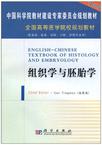组织学与胚胎学
2005-3
科学出版社发行部
高英茂 编
420
602000
无
随着改革开放的深入和国民经济的发展,我国的高等教育事业也正在走向世界,与国际接轨,高等教育的内容和方式也随之发生着深刻的变革。双语教材正是这种变革的重要体现。教育部发文提倡双语教学,大学生和研究生欢迎双语教学,高校教师努力开展双语教学,双语教学在高等教育中蔚然成风。双语教学需要相应的适用教材,高校师生呼唤适合我国国情的双语教材。目前,双语教材的编写和使用尚处于探索阶段,多数学校使用中文和英文两本教材。多年的双语教学实践使我们体会到:尽管中文和英文两本教材可拓宽学生的知识领域。并使学生学到地道的专业英语,但也严重增加了学生的学习和经济负担,超越了学生所能承受的知识基础和外语水平的极限,同时也增加了教师的授课负担。为此,在科学出版社的全力支持下,来自全国13所医学院校、有多年从事双语教学经验的18位教授,同心协力,编写了这本汉英双语教材。全书共26章,60多万字,插图334幅。全书既不是中英文两本式教材,也不是中英文对照式编排,而是以中文为主、中英文混编的双语教材。各章的章名和四级标题全部用双语标出,每章开头有英文要点(key points),要点之后有该章的英文概述(outline),正文中有数量不等的英文插入框(box),描述与该章内容密切相关的重要概念或最新进展。插图的说明和标字全部为英文,章后有英文复习题(questions for review),书未有英中文名词对照和索引。英文占全书版面字数的四分之一。我们总的指导思想是:组织胚胎学的基本内容仍用中文系统描述,英文表述的内容只限于基本内容的丰富和外延,不影响基本内容的系统性和完整性。这样既可保证不同外语水平的读者对专业知识的完整吸纳,又可促进读者专业外语水平的提高,同时也有利于拓宽学生的自学空间和方便于教师的备课、授课。
内容简介本书为21世纪高等医学院校双语系列教材之一。按照教学大纲要求,本书系统介绍组织学与胚胎学的基本内容,章前用英文列出该章内容提要,章后用英文进行小结,并用英文列出复习题。插图附英文说明。本书语言精练,知识点明确,强化三基三严;内容新颖,重点突出;图文并茂。适合医学院校五年制及七年制学生使用。
第1章 组织学绪论introduction to histology一、组织学的研究内容study contents of histology二、组织学的研究方法methods of histological research三、组织学的学习方法methods of learning histology第2章 上皮组织epithelial tissue一、被覆上皮covering epithelium二、上皮细胞的特殊结构specialization of epithelial cells三、腺上皮和腺glandular epithelium and gland四、上皮细胞的更新与再生epithelial cell renewal and reproduction第3章 固有结缔组织connective tissue proper一、疏松结缔组织loose connective tissue二、致密结缔组织dense connective tissue三、脂肪组织adipose tissue四、网状组织reticular tissue第4章 软骨和骨cartilage and bone一、软骨cartilage二、骨bone三、骨的发生osteogenesis第5章 血液和血细胞发生blood and hematopoiesis一、血液blood二、血细胞的发生hematopoiesis三、淋巴lymph第6章 肌组织muscle tissue一、骨骼肌skeletal muscle二、心肌cardiac muscle三、平滑肌smooth muscle第7章 神经组织nervous tissue一、神经元neuron二、突触synapse三、神经胶质细胞neuroglial cell四、神经营养因子和神经干细胞neurotrophic factors and neural stem cell五、神经纤维和神经nerve fiber and nerve六、神经末梢nerve ending第8章 神经系统nervous system一、大脑皮质cerebral cortex二、小脑皮质cerebellar cortex三、脊髓spinal cord四、神经节ganglia五、脑脊膜meninges六、血-脑屏障blood-brain barrier七、脉络丛和脑脊液choroid plexus and cerebrospinal fluid第9章 循环系统circulatory system一、心脏heart二、血管blood vessel三、微循环microcirculation四、淋巴管系统lymphatic vascular system第10章 免疫系统immune system一、免疫细胞immune cell二、淋巴组织lymphoid tissue三、淋巴器官lymphoid organ第11章 皮肤和皮肤附属器skin and skin appendage一、表皮epidermis二、真皮dermis三、皮下组织hypodermis四、皮肤的附属器skin appendages五、皮肤再生regeneration of skin第12章 内分泌系统endocrine system一、甲状腺thyroid gland二、甲状旁腺parathyroid gland三、肾上腺adrenal gland四、脑垂体hypophysis五、松果体pineal body六、弥散神经内分泌系统diffuse neuroendocrine system第13章 消化管digestive tract一、消化管壁的一般结构general structure of the digestive tract二、口腔oral cavity三、咽pharynx四、食管esophagus五、胃stomach六、小肠small intestine七、大肠large intestine八、消化管的内分泌细胞enteroendocrine cells in digestive tract第14章 消化腺digestive gland一、唾液腺salivary gland二、胰腺pancreas三、肝脏liver四、胆囊gallbladder第15章 呼吸系统respiratory system一、鼻腔nasal cavity二、喉larynx三、气管和支气管trachea and bronchus四、肺lung第16章 眼和耳eye and ear-、眼eye二、耳ear第17章 泌尿系统urinary system一、肾kidney二、输尿管ureter三、膀胱urinary bladder第18章 男性生殖系统male reprodustive system一、睾丸testis二、生殖管道genital ducts三、附属腺accessory genital gland四、阴茎penis第19章 女性生殖系统female reproductive system一、卵巢ovary二、输卵管oviduct三、子宫uterus四、阴道vagina五、乳腺mammary gland第20章 胚胎学总论general embryology一、配子发生和受精gametogenesis and fertilization二、胚前期的发育the development of embryo in preembryonic period三、胚期的发育the development of embryo in embryonic period四、胎期的发育和胚胎龄的计算the development of embryo in fetal period and the calculation of embryonic age五、胎膜和胎盘fetal membrane and placenta六、双胎、多胎和连体双胎twins,multiple births,conjoined twins第21章 颜面、颈和四肢的发生development of the face,neck and limbs一、鳃器的发生development of the branchial apparatus二、咽囊的演变derivatives of the pharyngeal pouches三、舌的发生development of the tongue四、甲状腺的发生development of the thyroid gland五、颜面的形成formation of the face六、腭的发生development of the palate七、牙的发生development of the teeth八、颈的形成formation of the neck九、四肢的发生development of the limbs十、颜面、颈和四肢的常见畸形congenital malformations of the face,neck,and limbs第22章 消化系统和呼吸系统的发生development of digestive and respiratory system一、消化系统的发生development of digestive system二、呼吸系统的发生development of respiratory system第23章 泌尿系统和生殖系统的发生development of urinary system and genital system一、泌尿系统的发生development of urinary system二、生殖系统的发生development of genital system第24章 心血管系统的发生development of the cardiovascular system一、原始心血管系统的建立establishment of the primitive cardiovascular system二、心脏的发生development of the heart三、胎儿血液循环和出生后的变化blood circulation of fetus and its changes四、心血管系统的常见畸形malformation of the cardiovascular system第25章 神经系统的发生development of nervous system一、神经管和神经嵴的发生和分化development and differentiation of neural tube and neural crest二、脊髓的发生development of spinal cord三、脑的发生development of brain四、神经节和周围神经的发生development of ganglion and peripheral nerve五、神经系统的常见畸形common malformations of nervous system第26章 眼和耳的发生 development of the eye and ear一、眼的发生development of the eye二、耳的发生development of the ear英文中文名词对照参考文献彩图
插图:3.胎盘的生理功能(Physiologieal functions of placenta)胎盘具有物质交换、内分泌及屏障功能。(1)物质交换和防卫屏障:妊娠期间,胎儿生长发育所需要的氧气和营养物质均通过胎盘从母体获得;胎儿代谢所产生的CO,和代谢废物也都是通过胎盘而排至母体。胎儿与母体之间的这种物质交换是通过胎盘膜实现的。随着胎儿的不断生长发育,胎盘膜的结构越来越薄,其物质交换功能也越来越强。胎儿血与母体血之间通过胎盘膜的这种物质交换过程的机制十分复杂,虽有不少研究成果,但至今仍有不少问题还未能阐明。一般认为,气体、水和电解质的交换通过简单扩散的方式进行,葡萄糖通过易化扩散进行,氨基酸通过主动运输进行,蛋白质通过胞饮和胞吐进行。脂肪酸可自由通过胎盘膜并参与胎儿的脂肪合成,脂溶性维生素以简单扩散的方式通过胎盘膜,水溶性维生素以主动转运的方式通过胎盘膜。大多数药物都可以通过胎盘膜而进入胎儿体内,因而妊娠期间不可轻易服用未经医生核准的药物,以免影响胎儿的正常发育。胎盘膜对多数细菌具有防卫屏障功能,但不能阻止病毒的通过,因而胎盘膜的这种屏障防卫功能是有限的。有些具有致畸作用的病毒、药物、化学物质通过胎盘膜进入发育中的胚胎后,可引起多种先天畸形。
《组织学与胚胎学(双语版)》由科学出版社出版。

无